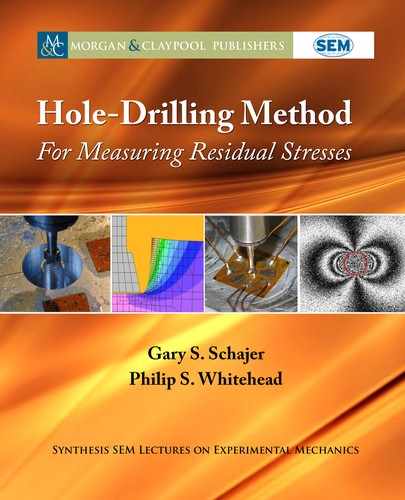4.2. SPECIMEN PREPARATION 71
In general, strain gauges are manufactured either as “open” rosettes or with encapsulated
grids. Various hole-drilling rosette patterns beyond the three types specified in E837 are com-
mercially available from several different manufacturers and can also give satisfactory results pro-
viding that the associated calibration constants are used when computing the residual stresses
from the measured strain data. Gauge manufacturers typically provide these calibration con-
stants either explicitly or within available computer software.
It is usual for the selection of the strain gauge rosette to be based on the layout of the
specimen, the size of the available target site and the depth to which residual stress data is
required. e most commonly used rosette choice is the 1/16”-size. is rosette is drilled with
20 x 0.050 mm increments (as recommended in ASTM E837), which provides a good level of
stress distribution detail and a final stress depth approaching 1 mm. If a greater level of stress
distribution detail is required (especially close to the surface) then the 1/32”-size rosette (drilled
with 20 x 0.025 mm increments to a final depth of 0.50 mm) may be more appropriate, provided
that the hole can be drilled with the commensurate level of precision. Alternatively, if residual
stress data is required to a greater depth, then the 1/8”-size rosette can provide data to depth
2 mm. Chapter 6 provides further details of gauge rosette layouts and sizes and examples of
installations.
4.2 SPECIMEN PREPARATION
e quality of the gauge installation directly controls the quality of the strain readings measured.
It is a requirement of the installation that, during the drilling process, all in-plane specimen
displacements that occur over the gauge area are transferred to the gauge backing material by
a continuous adhesive bond (or “glueline”) that is as thin as practicably possible. To ensure
that a sufficient level of adhesion is achieved between the specimen surface and strain gauge,
the specimen must be prepared in an appropriate manner. us, the installation of the strain
gauge rosette should be carried out in accordance with the gauge manufacturer’s instructions.
However, it is also to be noted that near-surface residual stresses within the specimen may form
an important part of the data to be collected from the specimen and any surface treatments made
to the specimen during preparation should be done in a manner that does not intrude on any
required specimen features. An example installation is shown in Figure 4.2 where a strain gauge
rosette has been bonded to a rough machined specimen. Show-through of the machining marks
provides a “witness” at the gauge surface confirming that a thin glueline has been achieved here.
In cases where the specimen surface is highly irregular, corroded or otherwise unsuitable
for direct installation of a strain gauge, some preliminary smoothing is required prior to final
preparation for gauge installation. is can usually be done using machining or abrasive meth-
ods, but care should be taken to minimize such surface treatments because any pre-existing
stresses close to the surface will be significantly redistributed by removal of surface material.
In addition, it is important that the surface preparation method selected must not introduce
spurious additional stresses into the newly formed surface, for example, by creation of excessive

72 4. STRAIN GAUGE TECHNIQUE: METHOD DESCRIPTION
Figure 4.2: Strain gauge rosette bonded to a rough-machined surface (photo courtesy of Stress-
craft Ltd.).
temperatures or local plastic deformations. Surface preparation must be by a carefully controlled
process using coolants wherever possible. As a general rule-of-thumb, the more rapid the ma-
terial removal in a given surface preparation process, the greater the potential for spurious stress
introduction. Ranked in order of least to most potential for spurious stress introduction (least to
greatest material removal speed), the following processes may be applied to irregular specimens
to produce surfaces for strain gauge installations:
• etching or super-polishing processes;
• coarse/medium grade silicon carbide paper (water cooled);
• coarse grade emery paper (dry); and
• flap wheel (low-speed and force).
More aggressive methods of material removal (for example, a high-speed abrasive disc)
can impart residual stresses to depths in excess of 1 mm and should be used only in the last re-
sort. e magnitudes and depths of spurious stresses introduced by various surface preparation
methods will depend on the abrasion conditions, specimen material, thickness, etc. e affected
material depth may be as little as 200 m for a flap wheel or 50 m for medium grade sili-
con carbide paper. In the case of etching or super-polishing processes, no additional stresses are
introduced. However, these processes are not always readily available or easily controlled to pro-
duce the required results; some experimentation will be required to determine the characteristics
of material removal rates using these methods.
..................Content has been hidden....................
You can't read the all page of ebook, please click here login for view all page.
